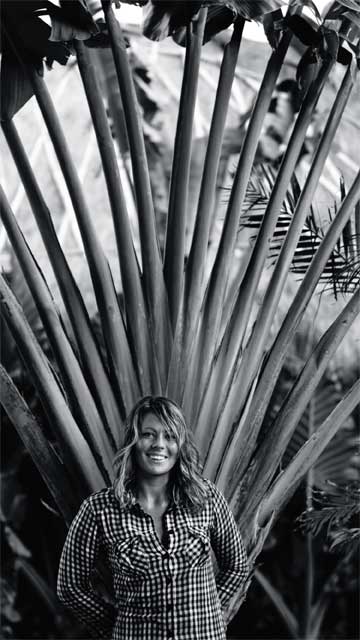
Just in time for the finals of the Roxy Pro in Biarritz this year, a little tale of when we were in Bali, the aptly named Island of the Gods, with British National Champion Sarah Beardmore last year
Words by Sam Haddad, photos by Jan Bul
It’s 7am and the air is already thick with heat. As we trudge through the deep sand scanning the sets on the horizon, a bead of sweat drips attractively off my chin. This is Nikko beach, Bali, the third spot we’ve checked since the crimson-clouded sunrise ushered in the day. A ridiculously grandiose 20-storey hotel juts out from the jungle cliff backdrop. Down the beach a bare face plus dormant JCBs suggests another is in the pipeline. In the distance a heavy right hand wave breaks clumsily, often closing out. It looks unsurfable but our two guides, Dave and Tom, based here but originally from California and the Gower in Wales, assure us as the tide goes out it’s going to go off.
Sarah Beardmore looks unconvinced. She’s had a week of surfing smallish beach breaks but the swell has picked up and she’s gagging to surf some of the kind of barrels for which Bali is famous. She’s keen for Uluwatu, the island’s flagship wave, where fellow WCT surfers Amandine Sanchez and Pauline Ado are planning to head, but the guides say the wind isn’t right. There’s no one else here but they assure her this is the spot. Finally she agrees to give it a go. I grab a water from a sweet, chatty lady at the perfectly-placed warung and settle on a driftwood log to watch.
The paddle out across the reef takes half an hour. Sarah will later tell me she was pretty nervous. “It looked quite small from the beach, and I didn’t realise how big it was until I started paddling out. The guys were like, “It’s deep through the channel, it’s not going to be a problem,” but we got half way out and it was sucking dry with 6ft waves landing on our heads. It was kinda scary.”
From the shore I can see the waves are starting to hold their shape better, from time to time rising up like serpents before gently falling into perfect barrels. But I don’t get an idea of their size until one of the guys (Tom from Wales, he’ll tell me with a Cheshire cat grin later) takes off on a wave that is at least double, if not triple, his height, and dances across its face. Sarah takes the third wave, carving a sweet bottom turn into its massive face before disappearing into the barrel. Though it collapsed on her head before she reached the end.

She says, “When I got out the back I could see the waves getting better as the tide pushed up like the guys said it would. I made sure they went first as it’s a new wave and new place. When it’s big it’s scary if you don’t quite know the reef and the way that the wave breaks.”
I ask if she was tempted to turn around and paddle back in. “Not really. After they took a wave each it was my turn or I’d have looked like a real pussy. You’ve got to just go and show you can do it.”
“I wasn’t quite ready for it but my first wave was probably the first wave I’ve got a stand up pit without needing to grab the rail. It was that wide. I could just see a bit of daylight at the end, it was pretty deep. I didn’t come out of it but I was in quite a while. The adrenaline was pumping, my legs were a bit shaky but it was good, I was enjoying it.”
As the guides had predicted the waves kept getting better and better and within half an hour there were at least 15 guys in the line up, with Sarah still the only girl. She says, “Other guys were paddling out but not everyone was taking off. According to the guides two of the guys out there apparently charge but they were fucking scared. Guys were coming in with boards broken in three places.”
She’s right. When we get up to leave it’s like a surfboard graveyard amongst the palm tree stumps. The consensus is that the waves were around 8ft, with the odd 10-footer thrown in for good measure. A 50-year old American with a six-pack, who was also taking off in the line up, walks past positively drooling, “Darling you can surf with me anytime.” As we head back to the car and our second spot of the morning, the guides are buzzing, albeit in a less letchy way. “I’ve never surfed with a girl in waves that big before. Let alone an English one!” Tom says.
Both Sarah Beardmore’s parents are British. She was born in England, though speaks with an Aussie twang as she spent her teenage years there. She didn’t start surfing until she was 16 and perhaps never would have if she hadn’t broken her leg playing football for her school, while trying to make the Australian national side. “I’ve always been very competitive and had a natural ability with sports,” she says. Three weeks before the leg break she’d fractured her ankle kickflipping her skateboard off some stairs.
Following countless operations, she gave up football for good. Then one day she borrowed her best friend’s surfboard and loved it right away. She says, “I’d done some bodyboarding and knew the waves, so I got quite into surfing quite quickly. I was competing within a year and a half.” She looked up to Serena Brooke, Rochelle Ballard Megan Abubo and Layne Beachley, the pros of the time and watched a lot of surf movies, such as Peaches, Blue Crush and 7 Girls. “There were a lot more female surf movies back when I was 17/18,” she says.
Now 26, she’d always wanted to come back and compete in the UK but her US and Australian sponsors hadn’t been so into the idea. Last year she did it anyway and was crowned British National Champion. She also finished in the top five of European surfers on the WQS and is now the first full-time Brit female on the tour since Robyn Davies.
I ask if she was worried about what the other UK surfers would think about her turning up on the British contest circuit. “I was really apprehensive about the reaction especially on the way over to my first event, and if I did well whether I’d be looked at as Australian and not true English. I’m sure there were some raised eyebrows here and there but at the same time the girls were great and I got along with them really well and hopefully I can help them push themselves really into competing in a more international field.”
She has a lot respect for the UK girls and how they surf when it’s cold and in many cases this past winter, snowy too and acknowledges she’s been spoilt in terms of waves. She says, “The weather doesn’t mean you can’t surf everyday but if you have to surf in a 5mm wetsuit then it’s lot less flexible than a bikini and you’re just not going to be able to stay out in the water long enough. I often say girls in the UK have probably surfed half the waves that I have.”
But she doesn’t think the weather is the only reason there have been so few British girls on the WQS. “I feel that people are content to stick to the UK market, rather than look to compete internationally. But I have been impressed with a lot of up and coming girls, say aged 14-18, who I’ve seen at the events. They just need a little more wave experience. You can develop the basic skills in the UK if you surf as much as you can, but you need to travel to places like Bali and then the wave knowledge will come quite quickly.” She also thinks some of the girls would benefit from taking gap years to surf or doing distance learning at uni, which is how she is studying for her business degree, while still being able to travel.

The second spot we hit at the sleepy resort of Sanur doesn’t match Nikko beach in terms of size or intensity, but the guys still enjoyed some sweet left hand barrels. Afterwards we sit on the beach with giant bottles of the local beer Bintang. The tide is now way out and the locals are walking out on the reef to fish, their nets slung over their shoulders. Tired but visibly amped from her exploits, Sarah reflects on the conditions, “This would be my dream day in terms of showcasing my surfing, rather than a contest. I don’t excel so well when I’m competing.”
“I think it’s part psychological, as I prefer bigger waves so when I go into a comp I’m not happy with the waves we’re surfing. You wouldn’t get waves like we had today at a contest at the moment on the WQS or even the WCT since they don’t have Fiji and Teahupo’o. It’s mainly beach breaks and a few points.”
I ask why, do people not want to see women surfing big barrels? “No they want to see the bikinis,” she laughs, before saying she doesn’t really want to get into the politics of it, but does feel the women “get left with the scraps” at a lot of the WQS and WCT events, with the guys always taking precedence, in terms of longer waiting periods and the pick of the conditions. She’s a big fan of stand-alone women’s events, such as the Roxy Pro Gold Coast, as a result.
That said, she does think surfing is a lot less macho than it used to be. “When I started out there weren’t that many girls surfing where as now there are loads. Sometimes there’s even more women in the water than guys, and with that the equality has gotten better and there’s more respect. Girls are surfing younger, they’re seen more in the water, the level is higher and the guys have had to adapt and accept it.”
“Sometimes you’ll take off and someone will see that you’re a girl and drop in inside of you. But usually after a few waves they’ll see you’re alright. It’s normally guys that can’t surf or have a bit of an ego problem that do that anyway, so you don’t worry about them because they’re wankers,” she laughs. But then having spent the day with her being the sole girl charging some of the biggest waves I’ve ever seen ridden live, I can’t really imagining much phasing her in the line up.
Thanks to Protest



